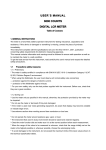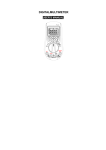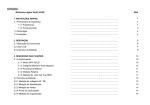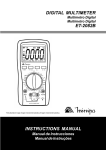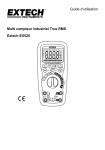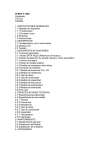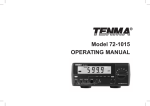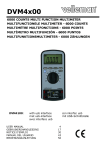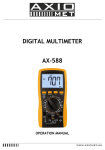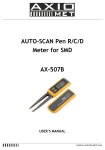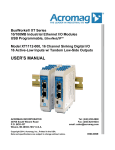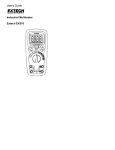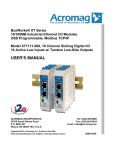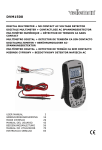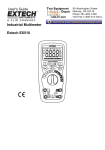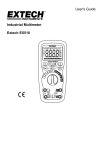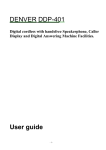Download ennoLogic eM860T True RMS Digital Multimeter User Manual
Transcript
eM860T True RMS Multimeter User Manual Version 1.4. Revised 3/19/2015. © 2015 ennoLogic™. All rights reserved. http://ennologic.com TABLE OF CONTENTS 1. GENERAL INSTRUCTIONS ................................................. 1 1.1 Precautionary Safety Measures .......................................... 1 1.1.1 Preliminary............................................................... 2 1.1.2 During Use ............................................................... 4 1.2 Battery Installation or Replacement ................................... 7 1.3 Symbols ............................................................................... 9 1.4 Instructions ......................................................................... 9 2. INSTRUMENT DESCRIPTION ........................................... 11 2.1 Main User Elements .......................................................... 11 2.2 LCD Display ....................................................................... 13 2.3 Keypad .............................................................................. 15 2.3.1 SELECT ................................................................... 15 2.3.2 HOLD/BACKLIGHT............................................. 15 2.3.3 RANGE ................................................................... 15 2.3.4 REL△ ....................................................................... 16 2.3.5 Hz % ........................................................................ 16 2.3.6 MAX/MIN .............................................................. 16 3. FUNCTION DESCRIPTION ................................................ 17 3.1 General Functions ............................................................. 17 3.1.1 DATA HOLD mode .............................................. 17 3.1.2 Manual ranging and Autorange mode............... 17 3.1.3 Battery Saver .......................................................... 18 3.1.4 Relative Measurement Mode ............................... 19 3.1.5 TRUE RMS Measurement .................................... 19 3.2 Measurement Functions ................................................... 20 3.2.1 AC and DC Voltage measurement ..................... 20 3.2.2 Resistance Measurement ...................................... 23 3.2.3 Capacitance Measurement ................................... 26 3.2.4 Continuity Check .................................................. 28 3.2.5 Diode Test .............................................................. 31 3.2.6 Frequency and Duty Cycle Measurement ......... 34 3.2.7 Temperature Measurement ................................. 35 3.2.8 Current Measurement .......................................... 36 3.2.9 NCV (Non-Contact Voltage Detect) ................... 38 4. TECHNICAL SPECIFICATIONS ........................................ 39 4.1 General specifications ....................................................... 39 4.2 Measurement Specifications ............................................ 40 4.2.1 Voltage .................................................................... 40 4.2.2 Frequency ............................................................... 42 4.2.3 Resistance ............................................................... 42 4.2.4 Diode Test .............................................................. 43 4.2.5 Continuity Check .................................................. 43 4.2.6 Capacitance ............................................................ 43 4.2.7 Temperature ........................................................... 44 4.2.8 Current.................................................................... 44 5. MAINTENANCE .................................................................. 45 5.1 General Maintenance ....................................................... 46 5.2 Fuse replacement ............................................................. 46 6. ACCESSORIES ....................................................................... 47 1. GENERAL INSTRUCTIONS This instrument complies with IEC 61010-1: 2001, CAT Ⅲ 1000V and CAT Ⅵ 600V overvoltage standards. See Specifications. To get the best service from this instrument, read this user's manual carefully and respect the detailed safety precautions. International symbols used on the Meter and in this manual are explained in chapter 1.2. 1.1 Precautionary Safety Measures Important Note: Limited Liability Cascadia Innovations is the exclusive distributor of all ennoLogic™ products. Except as explicitly stated, Cascadia Innovations is not liable for direct, indirect, incidental, or other types of damages arising out of, or resulting from the use of this product. By using the eM860T you agree to hold ennoLogic™ and Cascadia Innovations harmless for any and all consequences of the use of this product or application of data from the use of this instrument. 1 1.1.1 Preliminary As the possibilities of high transient over-voltages occurring in today’s power systems increase, more stringent safety standards are set for electrical test equipment. Transients on electrical systems (power grid, feeder or branch circuits) will trigger a series of incidents that may result in serious personal injury. To protect you against transients, safety must be built into the test equipment. Overvoltage category CAT I In brief Examples Electronic • Protected electronic equipment. • Equipment connected to (source) circuits in which measures are taken to limit transient over-voltages to an appropriately low level. • Any high-voltage, lowenergy source derived from a high winding resistance transformer, such as the high-voltage section of a copier. 2 CAT II CAT III Single-phase receptacle connected loads Three-phase distribution, including single-phase commercial lighting 3 • Appliance, portable tools, and other household and similar loads. • Outlet and long branch circuits. • Outlets at more than 10 meters (30 feet) from CAT III source. • Outlets at more that 20 meters (60 feet) from CAT IV source. • Equipment in fixed installations, such as switchgear and polyphase motors. • Bus and feeder in industrial plants. • Feeders and short branch circuits, distribution panel devices. • Lighting systems in larger buildings. • Appliance outlets with short connections to service entrance. CAT VI Three-phase at utility connection, any outdoor conductors • Refers to the “origin of installation”; i.e., where low-voltage connection is made to utility power. • Electricity meters, primary overcurrent protection equipment. • Outside and service entrance, service drop from pole to building, run between meter and panel. • Overhead line to detached building, underground line to well pump. When using this Multimeter, the user must observe all normal safety rules concerning: • protection against the dangers of electric current. • protection of the Multimeter against misuse. For your own safety, only use the test probes supplied with the instrument. Before use, check that they are in good condition. 1.1.2 During Use 4 • If the meter is used near noise generating equipment, be aware that display may become unstable or indicate large errors. • Do not use the meter or test leads if they look damaged. • Use the meter only as specified in this manual; otherwise, the protection provided by the meter may be impaired. • Use extreme caution when working around bare conductors or bus bars. • Do not operate the meter around explosive gas, vapor, or dust. • Verify a Meter's operation by measuring a known voltage. Do not use the Meter if it operates abnormally. Protection may be impaired. When in doubt, have the Meter serviced. • Use the proper terminals, function, and range for your measurements. • When the range of the value to be measured is unknown, check that the range initially set on the multimeter is the highest possible or, wherever possible, choose the autoranging mode. • To avoid damage to the instrument, do not exceed the maximum limits of the input values shown in the technical specification tables. • When the multimeter is linked to measurement circuits, do not touch unused terminals. • Caution when working with voltages above 60Vdc or 30V AC rms. Such voltages pose a shock hazard. 5 • When using the probes, keep your fingers behind the finger guards. • When making connections, connect the common test lead before connecting the live test lead; when disconnecting, disconnect the live test lead before disconnecting the common test lead. • Before changing functions, disconnect the test leads from the circuit under test. • For all DC functions, including manual or auto-ranging, to avoid the risk of shock due to possible improper reading, verify the presence of any AC voltages by first using the AC function. Then select a DC voltage range equal to or greater than the AC range. • Disconnect circuit power and discharge all high-voltage capacitors before testing resistance, continuity, diodes, or capacitance. • Never perform resistance or continuity measurements on live circuits. • Before measuring current, check the meter's fuse and turn off power to the circuit before connecting the meter to • the circuit. • In TV repair work, or when carrying out measurements on power switching circuits, remember that high amplitude voltage pulses at the test points can damage the multimeter. Use of a TV filter will attenuate any such pulses. 6 • Use just one 6F22 battery, properly installed in the Meter's battery case, to power the Meter. • Replace the battery as soon as the battery indicator ( ) appears. A low battery might produce false readings that can lead to electric shock and personal injury. • Do not measure voltages above 1000V in Category III, or 600V in Category Ⅳ installations. • When in REL mode, the “REL” symbol is displayed. Caution must be used because hazardous voltage may be present. • Do not operate the Meter with the case (or part of the case) removed. 1.2 Battery Installation or Replacement To avoid false readings, which could lead to possible electric shock or personal injury, replace the battery as soon as the battery indicator ( ) appears. Before installing or replacing the battery, disconnect test leads and/or any connectors from any circuit under test, turn the meter off and remove test leads from the input terminals. 7 1. Set rotary switch to the OFF position. 2. Disconnect test leads and/or any connectors from the terminals. 3. Remove the red protective rubber casing by carefully peeling it away from the black plastic enclosure. 4. Use a screwdriver to unscrew the two screws on the 5. 6. 7. 8. 9. battery cover, on the back of the unit near the bottom. Remove the battery cover from the meter. If you are replacing the battery: remove the used battery Install a new 9V battery (6F22). Replace the battery cover and tighten the screws. Attach protective rubber casing. 8 1.3 Symbols Symbols used in this manual and on the instrument: Caution: refer to the instruction manual. Incorrect use may result in damage to the device or its components. ~ AC (Alternating Current) DC (Direct Current) AC or DC Earth ground Double insulated Fuse Conforms to European Union directives 1.4 Instructions • Remove test leads from the Meter before opening the Meter case or battery cover. • When servicing the Meter, use only specified replacement parts. • Before opening up the instrument, always disconnect from all sources of electric current and make sure you are 9 • • • • • not charged with static electricity, which may destroy internal components. Any adjustment, maintenance or repair work carried out on the meter while it is live should be carried out only by appropriately qualified personnel, after having taken into account the instructions in this manual. A "qualified person" is someone who is familiar with the installation, construction and operation of the equipment and the hazards involved. He is trained and authorized to energize and de-energize circuits and equipment in accordance with established practices. When the instrument is opened up, remember that some internal capacitors can retain a dangerous potential even after the instrument is switched off. If any faults or abnormalities are observed, take the instrument out of service and ensure that it cannot be used until it has been checked out. If the meter is not going to be used for a long time, take out the battery and do not store the meter in high temperature or high humidity environments. 10 2. INSTRUMENT DESCRIPTION 2.1 Main User Elements The front panel is shown in Figure 2-1, and its user elements are described below: ① LCD display: Used for displaying measurement results and various symbols. ② Keypad: Measurement function keys. ③ Rotary switch: Used for selecting measurement functions. ④ V Hz : Connection terminal for the red test lead during voltage, resistance, capacitance, frequency, temperature, diode and continuity measurements. ⑤ uA/mA: Connection terminal for the red test lead during µA and mA measurements. ⑥ A: Connection terminal for the red test lead during 6A and 10A measurements. ⑦ COM: Connection terminal for the black test lead (common reference.) 11 Figure 2-1: Meter Front Panel 12 2.2 LCD Display Figure 2-2: LCD Display The LCD screen is shown in Figure 2-2 above, and the meanings of the symbols are explained in Table 1 below: No. Meaning Symbol 1 Indicates negative readings 2 Indicator for AC voltage or current 13 3 Indicator for DC voltage or current The meter is in the Autorange mode in which the meter automatically selects the range with the best resolution. 4 AUTO 5 NCV 6 H 7 REL 8 MAX Display maximum data 9 MIN Display minimum data 10 The meter is in Continuity Check mode. The meter is in Diode Test mode. 12 14 The meter is in Data Hold mode. The meter is in Relative Measurement mode. Low battery indication 11 13 No-contact AC Voltage detect ΩHz %°C°F KMΩ nμmFAV Measurement units This symbol means that the input is too large for the selected range. Table 1: LCD Display Symbols 14 2.3 Keypad 2.3.1 SELECT Change to the second function: 1. In the Ω and position Switches between Resistance measurement, Diode Test and Continuity Check. 2. In the A mA µA position Switches between DC and AC current. 3. Power-up Option Disables the automatic power-off feature when pressed (held down) while turning the Meter on. 2.3.2 HOLD/BACKLIGHT Press to enter and exit the Data Hold mode. To turn the backlight on and off, press and hold for 2 seconds. 2.3.3 RANGE At V~, V , Ω, A, mA and µA. 1. Press RANGE to enter the manual ranging mode. 15 2. Press RANGE to step through the ranges available for the selected function. 3. Press and hold RANGE for 2 seconds to return to autoranging. 2.3.4 REL△ Press REL△ △ to enter and exit the Relative measurement mode. (Except Hz/Duty) 2.3.5 Hz % At V~, A, mA and µA. 1. Press once to start the frequency counter. 2. Press again to enter duty (load factor) mode. 3. Press a third time to exit the frequency counter mode. 2.3.6 MAX/MIN This key is for measuring maximum and minimum values. 1. Press once to enter Max/Min mode. 2. Press again, and the LCD will display the Maximum Value. 3. Press a third time and the LCD will display the Minimum Value. 16 4. Press and hold for two seconds and the meter will return to the normal measurement state. (Except Hz/Duty and Capacitance) 3. FUNCTION DESCRIPTION 3.1 General Functions 3.1.1 DATA HOLD mode Data Hold mode causes the meter to stop updating the display. Enabling the Data Hold function in autorange mode switches the meter to Manual ranging mode, but the fullscale range remains the same. The Data Hold function can be cancelled by changing the measurement mode, pressing the RANGE key, or pushing the key again. To enter and exit Data Hold mode: key (short press). This freezes the 1. Press the display at the current value, H is displayed. 2. A second short press returns the meter to normal mode. 3.1.2 Manual ranging and Autorange mode The Meter has both manual ranging and autorange options. 17 • In autorange mode, the Meter selects the best range for the input detected. This allows you to switch test points without having to reset the range. • In manual ranging mode, you select the range. This allows you to override autorange and lock the meter into a specific range. • The Meter defaults to autorange mode in measurement functions that have more than one range. When the Meter is in autorange mode, AUTO is displayed. To enter and exit manual ranging mode: 1. Press the RANGE key. The Meter enters manual ranging mode. AUTO turns off. Each press of the RANGE key increments the range. When the highest range is reached, the Meter wraps back to the lowest range. NOTE: If you manually change the measurement range after entering the Data Hold mode, the Meter exits this mode. 2. To exit the manual ranging mode, press and hold down the RANGE key for two seconds. The Meter returns to the autorange mode and AUTO is displayed. 3.1.3 Battery Saver The Meter enters "Sleep mode" and blanks the display if the Meter is on but not used for 15 minutes. 18 Press the key or rotate the rotary switch to wake the meter up. To disable Sleep mode, hold down the SELECT key while turning the meter on. 3.1.4 Relative Measurement Mode The Meter will display relative measurements in all functions except frequency. To enter and exit the relative measurement mode: 1. With the Meter in the desired function, apply the test leads to the circuit to measure a value on which you want future measurements to be based. 2. Press the REL△ △ key to store the displayed value as reference value and activate relative measurement mode. The difference between the reference value and subsequent readings will be displayed from now on. 3. Press the REL△ △ key again to return the Meter to normal operation. 3.1.5 TRUE RMS Measurement All AC measurement values are true RMS (true root-meansquare) values. Frequency range is up to 1KHz. 19 3.2 Measurement Functions 3.2.1 AC and DC Voltage measurement To avoid electrical shock and/or damage to the instrument, do not attempt to take any voltage measurements that might exceed 1000Vdc or 1000Vac rms. To avoid electrical shock and/or damage to the instrument, do not apply more than 1000Vdc or 1000Vac rms between the common terminal and the earth ground. The Meter's voltage ranges are 600.0mV, 6.000V, 60.00V, 600.0V and 1000V. To measure AC or DC voltage (set up and connect the Meter as shown in Figure 3-1): 1. Set rotary switch to the DCV, ACV or AC/DCmV range. 2. Connect the black and red test leads to the COM and V terminals respectively. 3. Connect the test leads to the circuit being measured 4. Read the displayed value. The polarity of the red test lead connection will be indicated when making a DCV measurement. NOTE: The displayed values may be unstable especially in the 600mV range, even though you do not connect the test leads to a measurement source. 20 For better accuracy when measuring the DC offset of an AC voltage, measure the AC voltage first. Note the AC voltage range, then manually select a DC voltage range equal to or higher than the AC range. This improves the accuracy of the DC measurement by ensuring that the input protection circuits are not activated. Figure 3-1a: Measuring AC Voltage 21 Figure 3-1b: Measuring DC Voltage 22 3.2.2 Resistance Measurement To avoid electrical shock and/or damage to the instrument, disconnect circuit power and discharge all high-voltage capacitors before measuring resistance. The Meter's resistance ranges are 600.0Ω, 6.000kΩ, 60.00kΩ, 600.0kΩ, 6.000MΩ and 60.00MΩ. To measure resistance, set up the Meter as shown in Figure 3-2: 1. Set the rotary switch to Ω . 2. Connect the black and red test leads to the COM and VΩ terminals respectively. 3. Connect the test leads to the circuit or resistor being measured and read the displayed value. Some tips for measuring resistance: • The measured value of a resistor in a circuit is often different from the resistor's rated value. This is because the Meter's test current flows through all possible paths between the probe tips. • In order to ensure the best accuracy in measurements of low resistance, short the test leads before measurement and note the test probe resistance. Then subtract the test probe resistance from measured resistance. • The resistance function can produce enough voltage to forward-bias silicon diode or transistor junctions, 23 causing them to conduct. To avoid this, do not use the 60MΩ range for in-circuit resistance measurements. • In the 60MΩ range, the meter’s display may take a few seconds to stabilize. This is normal for high resistance measurements. • When the input is not connected, i.e. open circuit, the symbol "OL" will be displayed to indicate over-range condition. 24 Figure 3-2: Measuring Resistance 25 3.2.3 Capacitance Measurement To avoid electrical shock and/or damage to the instrument, disconnect circuit power and discharge all high-voltage capacitors before measuring capacitance. Use the DC voltage function to confirm that the capacitor is discharged. The Meter's capacitance ranges are 6.000nF, 60.00nF, 600.0nF, 6.000µF, 60.00µF, 600.0µF, 6.000mF, 60.00mF. To measure capacitance, set up the Meter as shown in Figure 3-3: 1. Set the rotary switch to Ω . 2. Press the SELECT key to select capacitance test. 3. Connect the black and red test leads to the COM and terminals respectively. 4. Connect the test leads to the capacitor being measured and read the displayed value. Some tips for measuring capacitance: The meter’s display may take a few seconds (>30 seconds in 600.0µF range) to stabilize. This is normal for high capacitance measurements. To improve the accuracy of measurements less than 6nF, subtract the residual capacitance of the Meter and leads. Below 100pF, the accuracy of measurements is unspecified. 26 Figure 3-3: Measuring Capacitance 27 3.2.4 Continuity Check To avoid electrical shock and/or damage to the instrument, disconnect circuit power and discharge all high-voltage capacitors before testing for Continuity. To test for continuity, set up the Meter as shown in Figure 3-4: 1. Set the rotary switch to . 2. Connect the black and red test leads to the COM and Ω terminals respectively. 3. Connect the test leads to the resistance in the circuit being measured. 4. A resistance between test leads of less than 50Ω is indicated by continuous beeping. NOTE: The Continuity test is commonly used to check for opens and shorts of a circuit. 28 Figure 3-4a: Checking Continuity - Short 29 Figure 3-4b: Checking Continuity - Open 30 3.2.5 Diode Test To avoid electrical shock and/or damage to the instrument, disconnect circuit power and discharge all high-voltage capacitors before testing diodes. To test a diode outside of a circuit, set up the Meter as shown in Figure 3-3: 1. Set the rotary switch to . 2. Press the SELECT key to select Diode Test. 3. Connect the black and red test leads to the COM and VΩ terminals respectively. 4. For forward-bias readings on any semiconductor component, place the red test lead on the component's anode and place the black test lead on the component's cathode. 5. The meter will show the approximate forward voltage of the diode. Inside a circuit, a good diode (Si) should still produce a forward bias reading of 0.5V to 0.8V; however, the reversebias reading can vary depending on the resistance of other pathways between the probe tips. 31 Figure 3-5a: Diode Test - Forward Bias 32 Figure 3-5b: Diode Test - Reverse Bias 33 3.2.6 Frequency and Duty Cycle Measurement Do not measure Frequency on high voltage (>1000V) circuits to avoid electrical shock hazard and/or damage to the instrument. The Meter can measure Frequency or Duty Cycle while making either an AC Voltage or AC Current measurement. To measure Frequency or Duty Cycle: 1. With the meter in the desired function (AC Voltage or AC Current), press the Hz % key. 2. Read the frequency of the AC signal on the display. 3. To make a duty cycle measurement, press the Hz % key again. 4. Read the percent of duty cycle on the display. 5. Set the rotary switch to the Hz range. 6. Insert the black and red test leads into the COM and Hz input terminals. 7. Connect the test lead tips in parallel with the circuit to be measured. And don’t touch any electrical conductors. 8. When in frequency measuring mode, press Hz % once to enter duty cycle measuring mode. Press it again to return to frequency measuring mode. 9. Read the measurement result on the display. NOTE: In a noisy environment, it is recommended to use shielded cables for measuring small signals. 34 3.2.7 Temperature Measurement To avoid electrical shock and/or damage to the instrument, do not apply more than 250VDC or 220VAC rms between the °C terminal and the COM terminal. To avoid electrical shock, do not use this instrument when voltages at the measurement surface exceed 60VDC or 24V rms. AC. To avoid damage or burns. Do not make temperature measurement in microwave ovens. To measure temperature: 1. Set the rotary switch to °C and the LCD will show the current environment temperature. 2. Insert ‘K’ type thermocouple into the COM terminal and °C terminal (or you can insert it by using a MultiFunction Socket) taking care to observe the correct polarity. 3. Touch the object to be measured with the thermocouple probe. 4. Read the temperature on the LCD after values have stabilized. 35 3.2.8 Current Measurement To avoid damage to the Meter or injury if the fuse blows, never attempt an in-circuit current measurement where the open-circuit potential to earth is greater than 1000V. To avoid damage to the meter, check the meter's fuse before proceeding. Use the proper terminals, function, and range for your measurement. Never place the probes in parallel with a circuit or component when the leads are plugged into the current terminals. The Meter's current ranges are 600.0µA, 6000µA, 60.00mA, 600.0mA, 6.000A and 10.00A. To measure current, set up the Meter as shown in Figure 3-6: 1. Turn off power to the circuit. Discharge all high voltage capacitors. 2. Set the rotary switch to the µA, mA or A range. 3. Press the SELECT key to select DCA or ACA measuring mode. 4. For currents up to 600mA, connect the black test lead to the COM terminal and the red test lead to the µA/mA terminal. For currents above 600mA and less than 10A, connect the red test lead to the A terminal instead. 5. Disconnect (break) the circuit path to be tested. 36 6. Connect or touch the black probe to the negative side of the break and connect or touch the red probe to the positive side of the break. (Reversing the leads will give a negative reading, but will not damage the Meter.) 7. Turn on power to the circuit; then read the display. Be sure to note the measurement units at the right side of the display (µA, mA or A). When "OL" is being displayed, it indicates an over-range situation and a higher range has to be selected. 8. Turn off power to the circuit and discharge all high voltage capacitors. Remove the Meter and restore the circuit to normal operation. 37 Figure 3-6: Measuring Current 3.2.9 NCV (Non-Contact Voltage Detect) Set the rotary switch to the /ACV mode. Press the SELECT key to switch to NCV detect mode. Hold the EFDETECT AREA at the top of the Meter close to the AC power cable or power socket. If AC electrical voltage is 38 present, the Buzzer warning will sound, and one or more bar symbols “-“ will be displayed on the LCD. The lowest detectable voltage is around 50V, 50/60Hz. The LCD will display EF, when detecting the AC voltage signal. The LCD display may indicate between one and four bars, from weak to strong (‘ - ’/‘ -- ’/‘ --- ’/‘ ---- ’.) 4. TECHNICAL SPECIFICATIONS 4.1 General specifications • Environmental conditions: 1000V CAT III and 600V CAT IV • Pollution degree: 2 • Altitude < 2000m • Operating temperature: 0~40°C, 32°F~122°F (<80% RH, <10°C non-condensing) • Storage temperature: -10~60°C, 14°F~140°F (<70% RH, battery removed) • Temperature Coefficient: 0.1×(specified accuracy) / °C (<18°C or >28°C) • MAX. Voltage between terminals and earth ground: 1000V AC rms or 1000V DC. • Fuse Protection: µA and mA: F 0.63A/1000V ∅10.3×38; A: F 10A/1000V ∅10.3×38. • Sample Rate: 3 times/sec for digital data. 39 • Display: 3 5/6 digits LCD display. Automatic indication of functions and symbols. • Range selection: automatic and manual. • Over Range indication: LCD will display "OL". • Low battery indication: The " " is displayed when battery power is too low to guarantee proper operation. • Polarity indication: "−" displayed automatically. • • • • Power source: 9V Battery type: 6F22. Dimensions: 190(L)×90(W)×40(H) mm. Weight: 500g approx. (battery included). 4.2 Measurement Specifications Accuracy is specified for one year after calibration, at operating temperatures of 18°C to 28°C, with relative humidity at less than 80%. Accuracy specifications take the form of: ± (% of Reading + Number of Least Significant Digits) 4.2.1 Voltage DCV: Range Resolution Accuracy 600mV 0.1mV ±(0.5% of rdg +5 digits) 40 6V 1mV ±(0.8% of rdg +5 digits) 60V 10mV 600V 100mV 1000V 1V ±(1.0% of rdg +2 digits) Accuracy ACV: Range Resolution 600mV 0.1mV 6V 1mV 60V 10mV 600V 100mV 750V 1V ±(1.0% of rdg + 5 digits) ±(1.5% of rdg + 5 digits) Above accuracies can be guaranteed within 5%~100% of the full range. The RMS meter has residual values within 10 counts when the test leads are shortened, but that will not affect the accuracy of measurement. 1. Frequency Range for ACV: 40Hz~400Hz. 2. Response for ACV: RMS measure, calibrated in rms of sine wave. 3. Overload Protection: 1000V DC or 1000V AC rms. 4. Input Impedance (Nominal): DC voltage: >10MΩ; AC voltage: >10MΩ. 41 4.2.2 Frequency Logic frequency (1Hz-1MHz) Range Resolution 99.99Hz 0.01 Hz 999.9Hz 0.1 Hz 9.999kHz 0.001kHz 99.99kHz 0.01kHz 999.9kHz 0.1kHz Accuracy ±(0.1% of rdg+3digits) Linear frequency (6HZ~10KHZ) Range Resolution 99.99Hz 0.01 Hz 999.9Hz 0.1 Hz 9.999kHz 0.001kHz Accuracy ±(0.05% of rdg+8digits) Above accuracies can be guaranteed within 10%~100% of the full range. 4.2.3 Resistance Range Resolution Accuracy 600.0Ω 0.1Ω ±(0.5% of rdg+3 digits) 6.000kΩ 1Ω 60.00kΩ 10Ω 600.0kΩ 100Ω ±(0.5% of rdg+2 digits) 42 6.000MΩ 1kΩ 60.00MΩ 10kΩ ±(1.5% of rdg+5 digits) 4.2.4 Diode Test Range 1V Resolution Test Condition 0.001V Forward Bias DC current approximately 1mA. Reverse Bias DC voltage approximately 1.5V. 4.2.5 Continuity Check Range Resolution Test Condition 600Ω 0.1Ω Open circuit voltage: approx. 0.5V Note: Continuity beeper at ≤ 50Ω 4.2.6 Capacitance Range Resolution Accuracy 6nF 1pF ±(5.0% of rdg +20 digits) 60nF 10pF ±(3.0% of rdg +20 digits) 600nF 100pF 6µF 1nF 60µF 10nF ± (5.0% of rdg+10 digits) 43 600µF 100nF 6mF 1µF ±(5.0% of rdg +20 digits) 4.2.7 Temperature Range Resolution -200~0℃ 0~400℃ Accuracy ±(5.0% of rdg + 4°C) 1°C ±(2.0% of rdg+ 3°C) 400~1200℃ ±(2.0% of rdg+ 2°C) Note: The temperature specifications do not include thermocouple errors. 4.2.8 Current DCA: Range 600µA 6000µA 60mA 600mA 6A 10A Resolution 0.1µA 1µA 0.01mA 0.1mA 1mA 10mA Accuracy ±(1.5% of rdg+3 digits) ±(1.5% of rdg+3 digits) ±(1.5% of rdg+5 digits) ACA: Range Resolution 600µA 0.1µA 6000µA 1µA Accuracy ±(1.8% of rdg+5 digits) 44 60mA 0.01mA 600mA 0.1mA 6A 1mA 10A 10mA ±(1.8% of rdg+5 digits) ±(3.0% of rdg+8 digits) Above accuracies can be guaranteed within 5%~100% of the full range. The true RMS meter has residual values within 10 counts when the test leads are shortened, but that will not affect the accuracy of measurement. 1. Frequency Range for ACA: 40Hz-400Hz 2. Overload protection: F 10A/1000V fuse for 10A Overload protection: F 0.63A/1000V fuse for µA and mA ranges. 3. Maximum input current: 600mA DC or 600mA AC rms for µA and mA ranges, 10A DC or 10A AC rms for 10A ranges. 4. For measurements >6A, 15 seconds ON each 10 minutes; Above 10A unspecified. 5. MAINTENANCE This section provides basic maintenance information, including fuse and battery replacement instructions. Do not attempt to repair or service your Meter unless you are qualified to do so and have the relevant calibration, performance test, and service information. 45 5.1 General Maintenance To avoid electrical shock or damage to the meter, do not get water inside the case. Remove the test leads and any input signals before opening the case Periodically wipe the case with a damp cloth and mild detergent. Do not use abrasives or solvents. Dirt or moisture in the terminals can affect readings. To clean the terminals: Turn the meter off and remove all test leads. Shake out any dirt that may be in the terminals. Soak a new swab with a cleaning and oiling agent (such as WD-40). Work the swab around in each terminal. The oiling agent insulates the terminals from moisture-related contamination. 5.2 Fuse replacement Before replacing the fuse, disconnect test leads and/or any connectors from any circuit under test. To prevent damage or injury replace the fuse only with one of correct ratings. 46 1. Set rotary switch to the OFF position. 2. Disconnect test leads and/or any connectors from the terminals. 3. Use a screwdriver to unlock the four screws on the rear cover. 4. Remove the rear cover from the meter. 5. Remove the fuse by gently prying one end loose, then slide the fuse out of its bracket. 6. Only install replacement fuses with the following ratings: F 0.63A/1000V ∅10.3×38 and F 10A/1000V ∅10.3×38 7. Replace the rear cover and tighten the screws. 6. ACCESSORIES Package contents: • Multimeter eM860T • Test Leads (black and red) • K Type Thermocouple Probe • 9V Battery • Carrying Case • User Manual 47 48 ennoLogic.com PO Box 25207 Eugene, OR 97402
























































